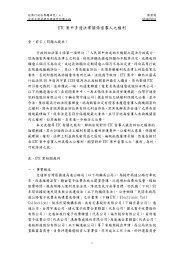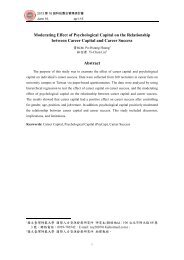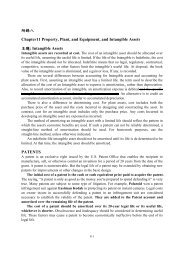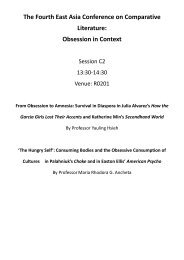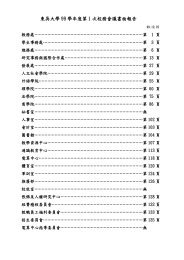The Power of the Pill: Oral Contraceptives and Women's ... - Mail
The Power of the Pill: Oral Contraceptives and Women's ... - Mail
The Power of the Pill: Oral Contraceptives and Women's ... - Mail
Create successful ePaper yourself
Turn your PDF publications into a flip-book with our unique Google optimized e-Paper software.
power <strong>of</strong> <strong>the</strong> pill 763<br />
<strong>The</strong> negative effect <strong>of</strong> pill access on divorce is not caused by an<br />
increase in <strong>the</strong> share who never married (see cols. 8 <strong>and</strong> 9). Ra<strong>the</strong>r,<br />
improved pill access <strong>and</strong> greater pill usage for young women are negatively<br />
related to divorce even among <strong>the</strong> ever married. Although <strong>the</strong><br />
overall divorce rate skyrocketed from 1970 to 1990, <strong>the</strong> rise in divorce<br />
actually slowed as birth cohorts with greater pill access moved into <strong>the</strong><br />
30–49-year age group. 51 <strong>The</strong> effect suggests that pill access improved<br />
<strong>the</strong> quality <strong>of</strong> marriage matches by increasing <strong>the</strong> age at first marriage.<br />
Individuals marrying later have a better sense <strong>of</strong> <strong>the</strong>ir preferences, <strong>and</strong><br />
<strong>the</strong> effect outweighed <strong>the</strong> possible spur to divorce from improved careers<br />
<strong>and</strong> lower birth rates from <strong>the</strong> pill. 52<br />
We have explored <strong>the</strong> robustness <strong>of</strong> <strong>the</strong> results presented in table 5<br />
along several dimensions. <strong>The</strong> impact <strong>of</strong> pill usage is invariant to various<br />
measures, for example, using <strong>the</strong> figure 2 data on first family planning<br />
visits before age 21 ra<strong>the</strong>r than those given by <strong>the</strong> fraction taking <strong>the</strong><br />
pill before age 21. <strong>The</strong> findings are also not much affected by using<br />
measures for pill access at different ages (e.g., age 17 or younger <strong>and</strong><br />
ages 18–20) <strong>and</strong> from looking at a narrower range <strong>of</strong> cohorts (e.g.,<br />
women aged 35–44 years for <strong>the</strong> birth cohorts from 1926 to 1955).<br />
Finally, <strong>the</strong> qualitative findings for <strong>the</strong> outcomes in table 5 are similar<br />
if <strong>the</strong> sample is exp<strong>and</strong>ed to include women with any college <strong>and</strong> all<br />
women regardless <strong>of</strong> education to account for <strong>the</strong> possible dependence<br />
<strong>of</strong> college graduation on pill <strong>and</strong> abortion access.<br />
IV.<br />
<strong>The</strong> Case for <strong>the</strong> <strong>Power</strong> <strong>of</strong> <strong>the</strong> <strong>Pill</strong><br />
We have built a case for <strong>the</strong> power <strong>of</strong> <strong>the</strong> pill based on <strong>the</strong> timing <strong>of</strong><br />
changes in pill access, career change, <strong>and</strong> <strong>the</strong> age at first marriage, <strong>and</strong><br />
we have estimated formal econometric relationships exploiting crossstate<br />
<strong>and</strong> cross-cohort variation.<br />
Despite FDA approval <strong>of</strong> <strong>the</strong> pill in 1960 for contraceptive use <strong>and</strong><br />
its rapid diffusion among married women, young, unmarried women<br />
did not greatly increase pill usage until <strong>the</strong> late 1960s to early 1970s.<br />
51<br />
<strong>The</strong> estimates in col. 8 indicate that improved access to abortion, as proxied by <strong>the</strong><br />
actual abortion rate from ages 18 to 21, is associated with a large reduction in divorce.<br />
But <strong>the</strong> impact <strong>of</strong> abortion access on reducing divorce is much smaller (<strong>and</strong> not statistically<br />
significant) in specifications using <strong>the</strong> (arguably more exogenous) abortion legalization<br />
variable as shown in cols. 7 <strong>and</strong> 9.<br />
52<br />
Michael (1988) presents an annual time-series analysis <strong>of</strong> <strong>the</strong> U.S. divorce rate from<br />
1920 to 1974. He finds that an index <strong>of</strong> <strong>the</strong> overall diffusion <strong>of</strong> new contraceptive technologies<br />
(pill <strong>and</strong> intrauterine devices) helps explain <strong>the</strong> acceleration in growth <strong>of</strong> <strong>the</strong><br />
U.S. divorce rate in <strong>the</strong> 1960s. This contrasts with our finding that greater pill access is<br />
associated with a reduction in <strong>the</strong> growth <strong>of</strong> divorce across successive cohorts <strong>of</strong> college<br />
women. Our approach differs by examining individual year <strong>of</strong> birth cohorts, controlling<br />
for aggregate year effects, <strong>and</strong> looking at <strong>the</strong> impact <strong>of</strong> pill access for young, single college<br />
women.




